A Stability Analysis of Solutions in Boundary Layer Flow and Heat Transfer of Carbon Nanotubes over a Moving Plate with Slip Effect
Abstract
:1. Introduction
2. Problem Formulation
3. Flow Stability
4. Results and Discussion
5. Conclusions
- The skin friction decreases with an increase of carbon nanotubes volume fraction, whereas the heat transfer rate increases.
- Single-wall CNTs are more efficient than multi-wall CNTs in skin friction and heat transfer rate.
- Kerosene-based CNTs have higher skin friction and heat transfer rates than water-based CNTs.
- The range of solutions widely expanded with an increment of slip parameter.
- For the opposing flow, slip parameter increases the skin friction coefficient and heat transfer.
- The existence of unique solutions occurs when the plate moves in the same direction whereas dual solutions occur when the plate move in the opposite direction .
- The first solution was a stable solution and physically relevant, while the second solution was an unstable solution.
Author Contributions
Acknowledgments
Conflicts of Interest
References
- Das, S.K.; Choi, S.U.; Yu, W.; Pradeep, T. Nanofluids: Science and Technology; John Wiley & Sons: Hoboken, NJ, USA, 2007. [Google Scholar]
- Chol, S.U.S.; Estman, J.A. Enhancing thermal conductivity of fluids with nanoparticles. ASME Publ. -Fed 1995, 231, 99–106. [Google Scholar]
- Halelfadl, S.; Maré, T.; Estellé, P. Efficiency of carbon nanotubes water based nanofluids as coolants. Exp. Therm. Fluid Sci. 2014, 53, 104–110. [Google Scholar] [CrossRef] [Green Version]
- Choi, S.U.S.; Zhang, Z.G.; Yu, W.; Lockwood, F.E.; Grulke, E.A. Anomalous thermal conductivity enhancement in nanotube suspensions. Appl. Phys. Lett. 2001, 79, 2252–2254. [Google Scholar] [CrossRef]
- Maré, T.; Halelfadl, S.; Sow, O.; Estellé, P.; Duret, S.; Bazantay, F. Comparison of the thermal performances of two nanofluids at low temperature in a plate heat exchanger. Exp. Therm. Fluid Sci. 2011, 35, 1535–1543. [Google Scholar] [CrossRef] [Green Version]
- Liu, M.S.; Lin, M.C.C.; Huang, I.T.; Wang, C.C. Enhancement of thermal conductivity with carbon nanotube for nanofluids. Int. Commun. Heat Mass Transf. 2005, 32, 1202–1210. [Google Scholar] [CrossRef]
- Garg, P.; Alvarado, J.L.; Marsh, C.; Carlson, T.A.; Kessler, D.A.; Annamalai, K. An experimental study on the effect of ultrasonication on viscosity and heat transfer performance of multi-wall carbon nanotube-based aqueous nanofluids. Int. J. Heat Mass Transf. 2009, 52, 5090–5101. [Google Scholar] [CrossRef]
- Xue, Q.Z. Model for thermal conductivity of carbon nanotube-based composites. Phys. B Condens. Matter 2005, 368, 302–307. [Google Scholar] [CrossRef]
- Ding, Y.; Alias, H.; Wen, D.; Williams, R.A. Heat transfer of aqueous suspensions of carbon nanotubes (CNT nanofluids). Int. J. Heat Mass Transf. 2006, 49, 240–250. [Google Scholar] [CrossRef]
- Kumaresan, V.; Velraj, R.; Das, S.K. Convective heat transfer characteristics of secondary refrigerant based CNT nanofluids in a tubular heat exchanger. Int. J. Refrig. 2012, 35, 2287–2296. [Google Scholar] [CrossRef]
- Blasius, H. Grenzschichten in Flussigkeiten mit kleiner Reibung. Z. Angew. Math. Phys. 1908, 56, 1–37. [Google Scholar]
- Wang, L. A new algorithm for solving classical Blasius equation. Appl. Math. Comput. 2004, 157, 1–9. [Google Scholar] [CrossRef]
- Cortell, R. Numerical solutions of the classical Blasius flat-plate problem. Appl. Math. Comput. 2005, 170, 706–710. [Google Scholar] [CrossRef]
- Sakiadis, B.C. Boundary-layer behavior on continuous solid surfaces: I. Boundary-layer equations for two-dimensional and axisymmetric flow. AIChE J. 1961, 7, 26–28. [Google Scholar] [CrossRef]
- Ishak, A.; Nazar, R.; Pop, I. Flow and heat transfer characteristics on a moving flat plate in a parallel stream with constant surface heat flux. Heat Mass Transf. 2009, 45, 563–567. [Google Scholar] [CrossRef]
- Ishak, A.; Nazar, R.; Pop, I. The effects of transpiration on the flow and heat transfer over a moving permeable surface in a parallel stream. Chem. Eng. J. 2009, 148, 63–67. [Google Scholar] [CrossRef]
- Bachok, N.; Ishak, A.; Pop, I. Flow and heat transfer characteristics on a moving plate in a nanofluid. Int. J. Heat Mass Transf. 2012, 55, 642–648. [Google Scholar] [CrossRef]
- Bhattacharyya, K.; Mukhopadhyay, S.; Layek, G.C. MHD boundary layer slip flow and heat transfer over a flat plate. Chin. Phys. Lett. 2011, 28, 024701. [Google Scholar] [CrossRef]
- Bhattacharyya, K.; Mukhopadhyay, S.; Layek, G.C. Steady boundary layer slip flow and heat transfer over a flat porous plate embedded in a porous media. J. Pet. Sci. Eng. 2011, 78, 304–309. [Google Scholar] [CrossRef]
- Bhattacharyya, K.; Layek, G.C.; Gorla, R.S.R. Slip effect on boundary layer flow on a moving flat plate in a parallel free stream. Int. J. Fluid Mech. Res. 2012, 39. [Google Scholar] [CrossRef]
- Bachok, N.; Najib, N.; Arifin, N.M.; Senu, N. Stability of dual solution boundary layer flow and heat transfer on a moving plate in a copper-water nanofluid with slip effect. WSEAS Trans. Fluid Mech. 2016, 11, 151–158. [Google Scholar] [CrossRef]
- Khan, W.A.; Khan, Z.H.; Rahi, M. Fluid flow and heat transfer of carbon nanotubes along a flat plate with Navier slip boundary. Appl. Nanosci. 2014, 4, 633–641. [Google Scholar] [CrossRef]
- Imtiaz, M.; Hayat, T.; Alsaedi, A.; Ahmad, B. Convective flow of carbon nanotubes between rotating stretchable disks with thermal radiation effects. Int. J. Heat Mass Transf. 2016, 101, 948–957. [Google Scholar] [CrossRef]
- Hayat, T.; Haider, F.; Muhammad, T.; Alsaedi, A. Three dimensional rotating flow of carbon nanotubes with Darcy-Forchheimer porous medium. PLoS ONE 2017, 12, e0179576. [Google Scholar] [CrossRef] [PubMed]
- Hayat, T.; Hussain, Z.; Alsaedi, A.; Ahmad, B. Heterogeneous-homogeneous reactions and melting heat transfer effects in flow with carbon nanotubes. J. Mol. Liq. 2016, 220, 200–207. [Google Scholar] [CrossRef]
- Sreedevi, P.; Reddy, P.S.; Chamka, A.J. Magneto-hydrodynamics heat and mass transfer analysis of single and multi-wall carbon nanotubes over vertical cone with convective boundary condition. Int. J. Mech. Sci. 2018, 135, 646–655. [Google Scholar] [CrossRef]
- Merkin, J.H. On dual solutions occurring in mixed convection in a porous medium. J. Eng. Math. 1985, 20, 171–179. [Google Scholar] [CrossRef]
- Weidman, P.D.; Kubitschek, D.G.; Davis, A.M.J. The effect of transpiration on self-similar boundary layer flow over moving surfaces. Int. J. Eng. Sci. 2006, 44, 730–737. [Google Scholar] [CrossRef]
- Merrill, K.; Beauchesne, M.; Previte, J.; Paullet, J.; Weidman, P. Final steady flow near a stagnation point on a vertical surface in a porous medium. Int. J. Heat Mass Transf. 2006, 49, 4681–4686. [Google Scholar] [CrossRef]
- Harris, S.D.; Ingham, D.B.; Pop, I. Mixed convection boundary-layer flow near the stagnation point on a vertical surface in a porous medium: Brinkman model with slip. Transp. Porous Media 2009, 77, 267–285. [Google Scholar] [CrossRef]
- Oztop, H.F.; Abu-Nada, E. Numerical study of natural convection in partially heated rectangular enclosures filled with nanofluids. In. J. Heat Fluid Flow 2008, 29, 1326–1336. [Google Scholar] [CrossRef]
- Afzal, N.; Badaruddin, A.; Elgarvi, A.A. Momentum and heat transport on a continuous flat surface moving in a parallel stream. Int. J. Heat Mass Transf. 1993, 36, 3399–3403. [Google Scholar] [CrossRef]
- Kierzenka, J.; Shampine, L.F. A BVP solver based on residual control and the Maltab PSE. ACM Trans. Math. Softw. 2001, 27, 299–316. [Google Scholar] [CrossRef]
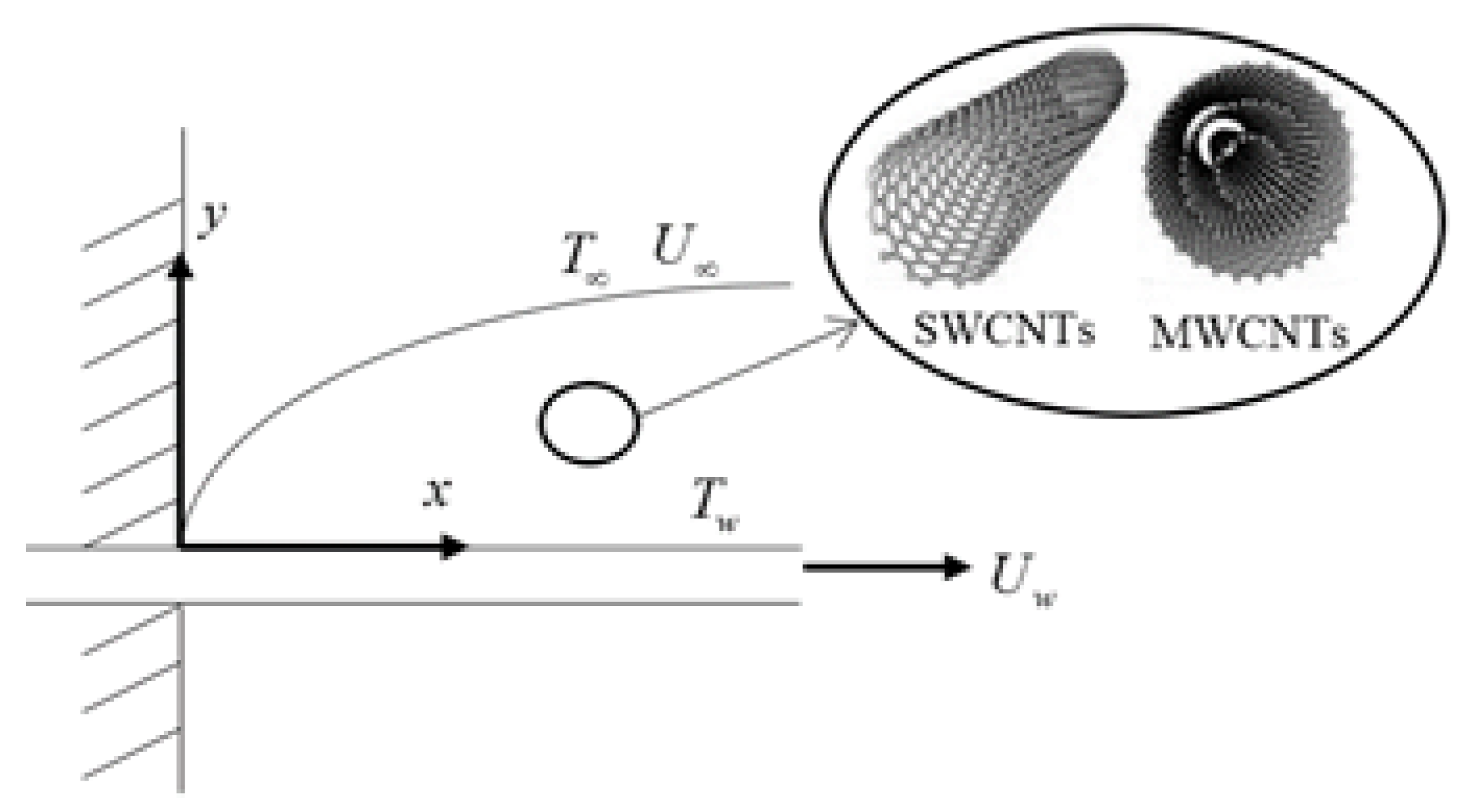
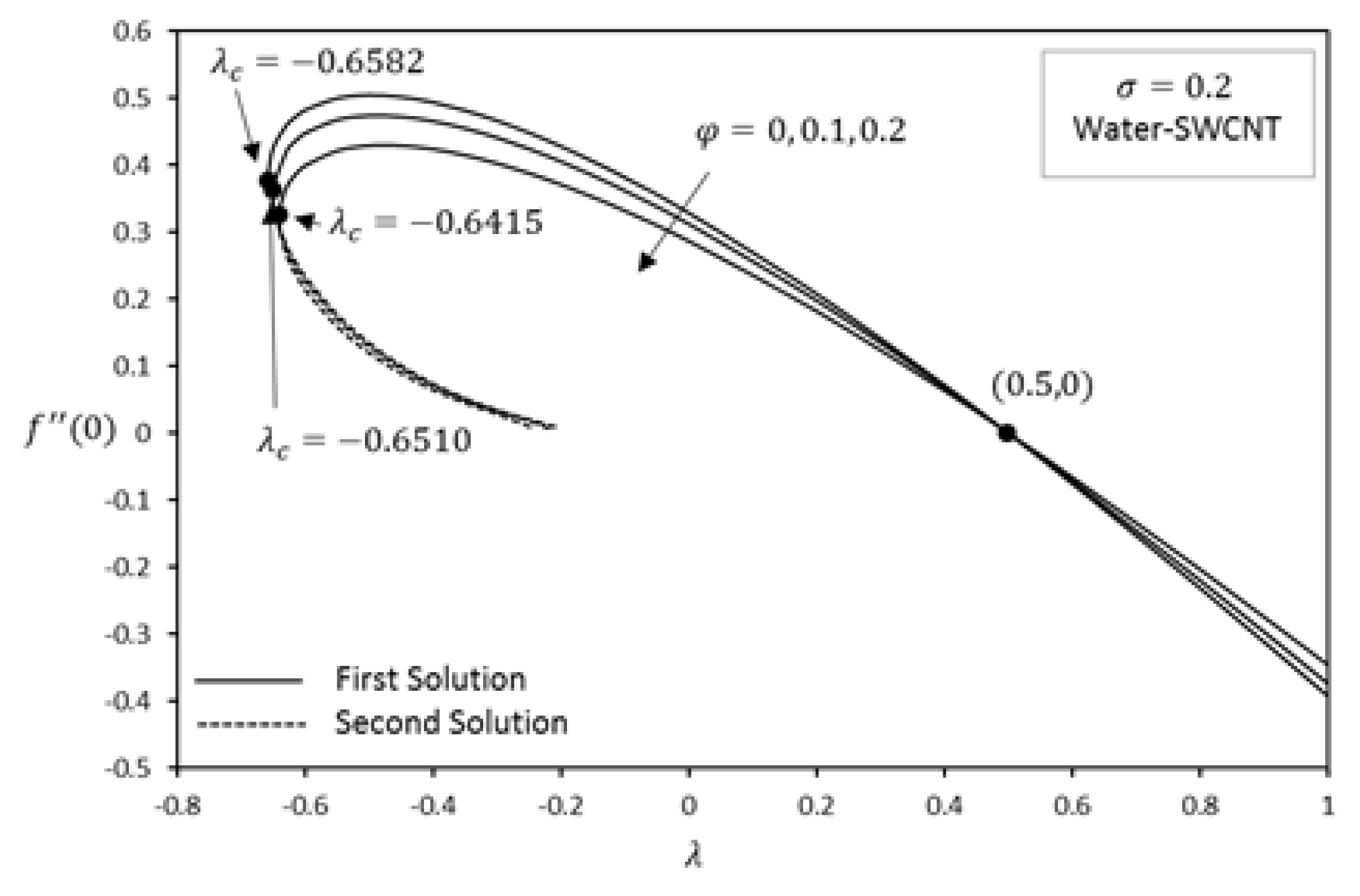
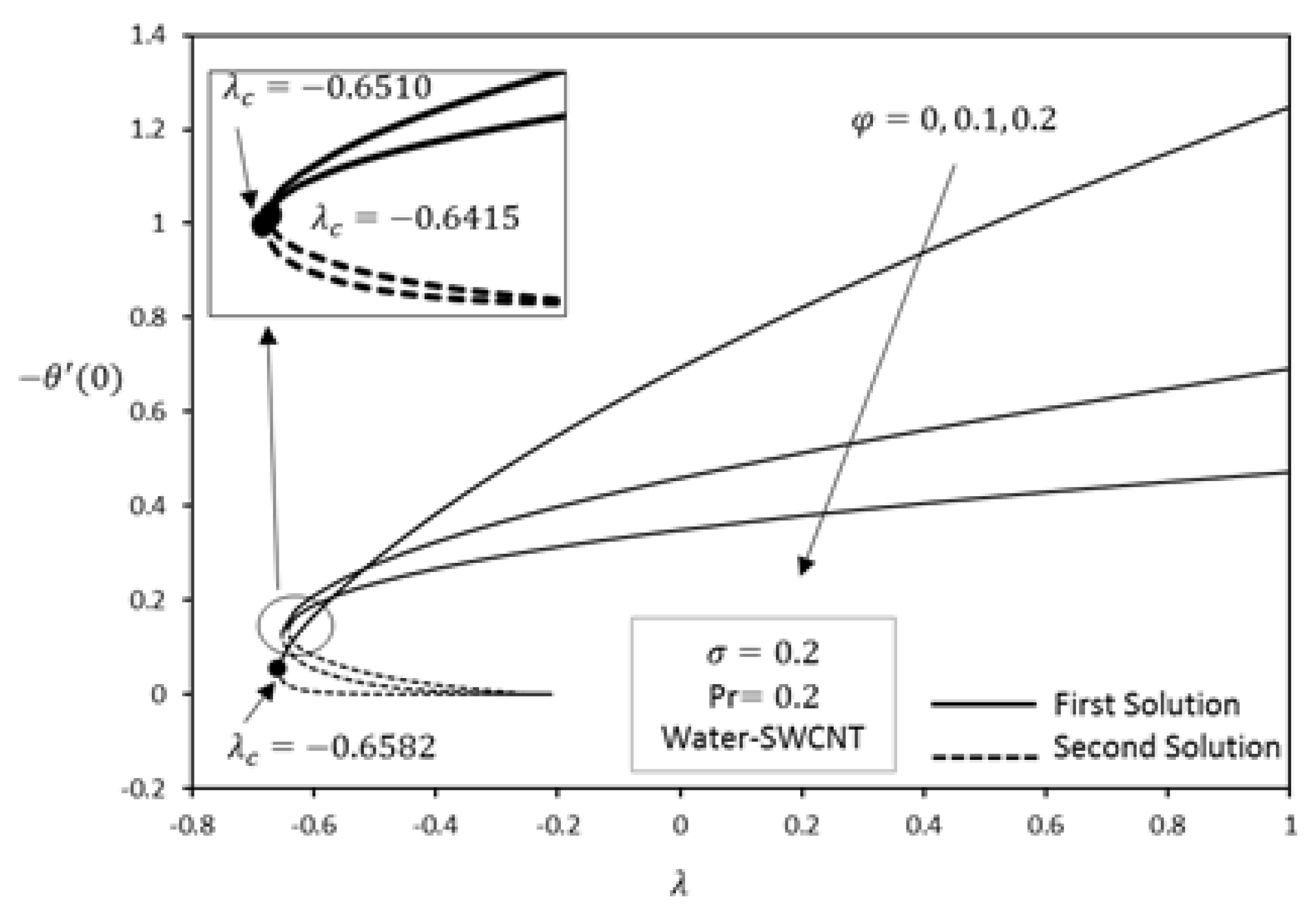


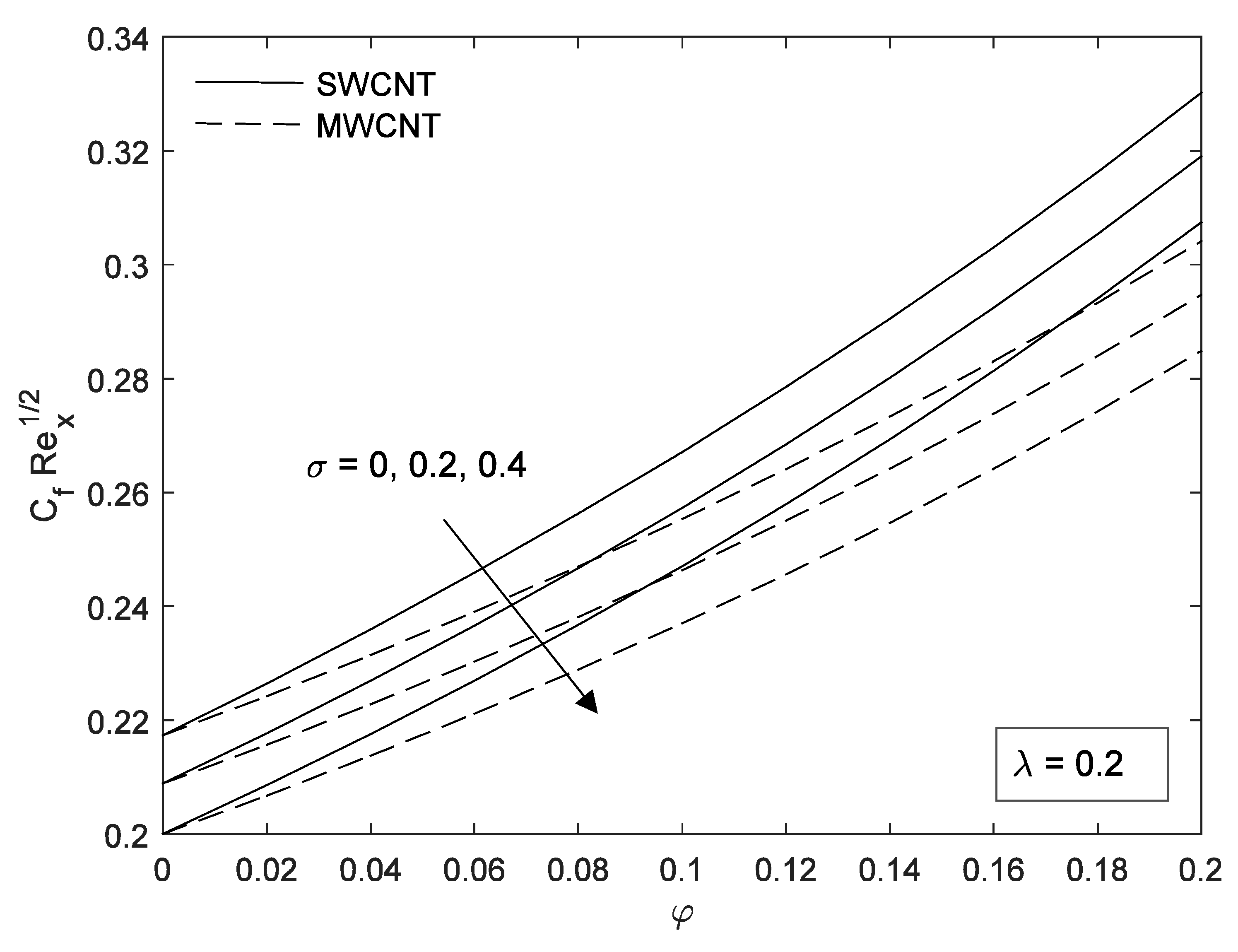
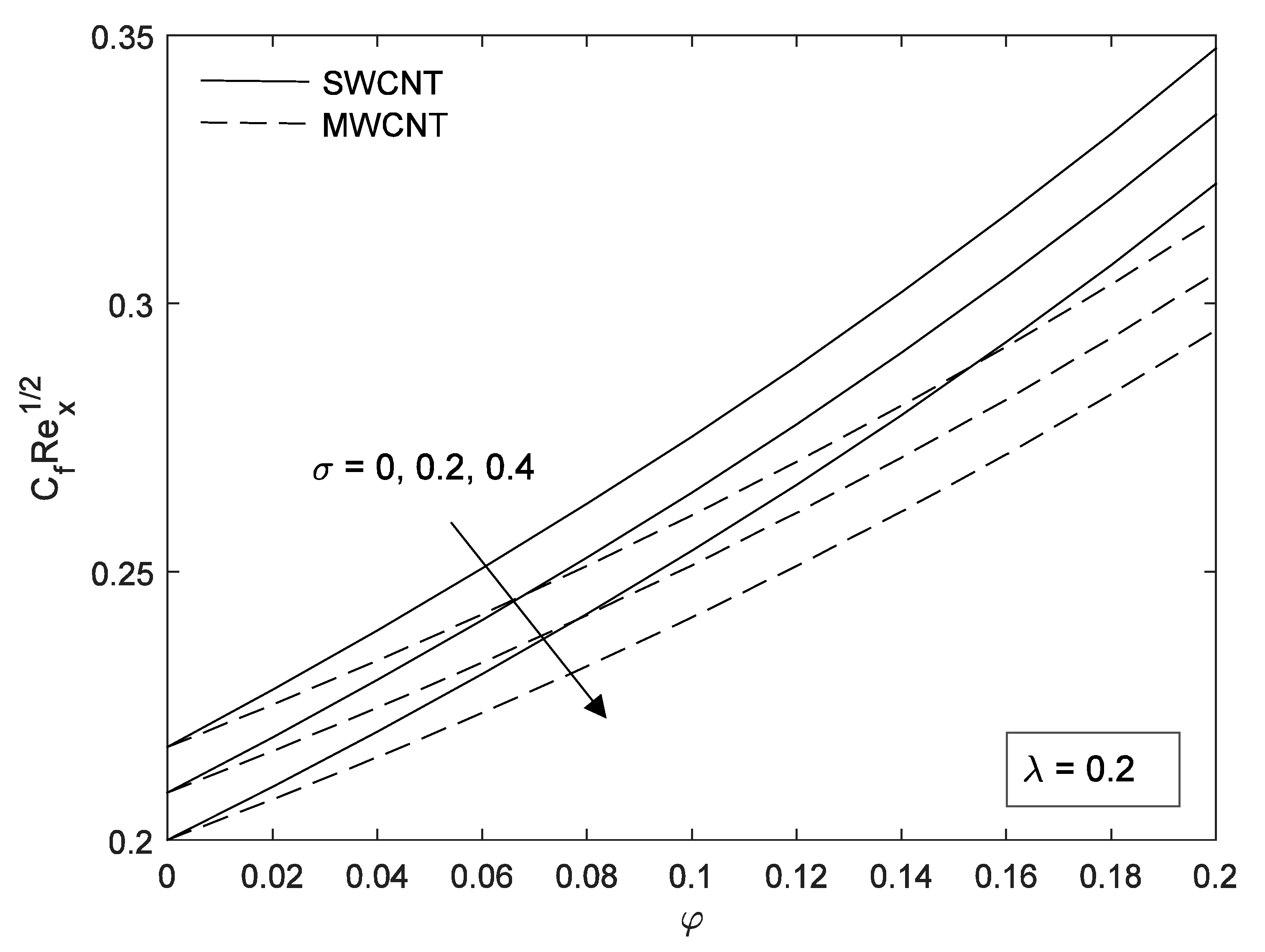
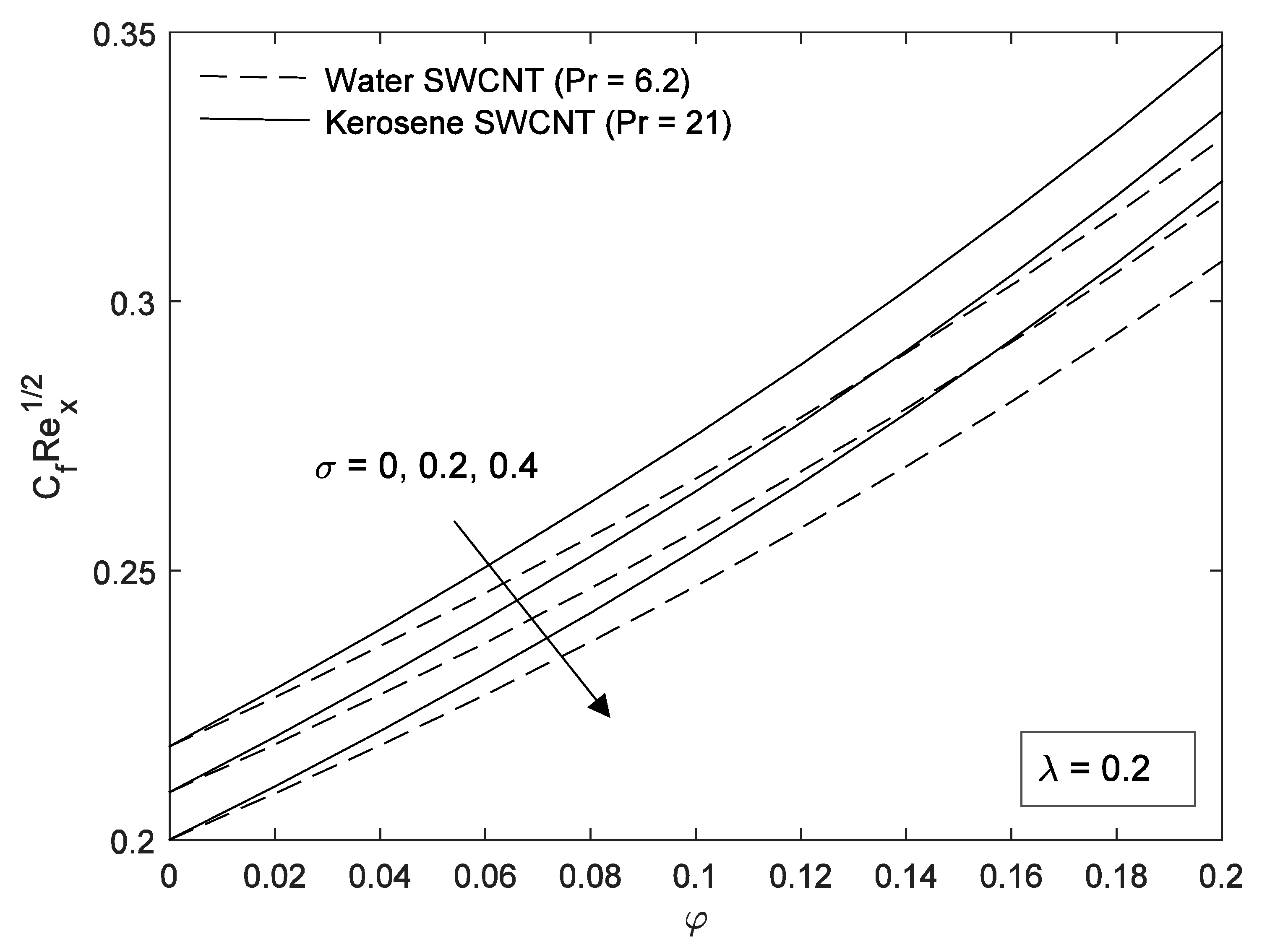

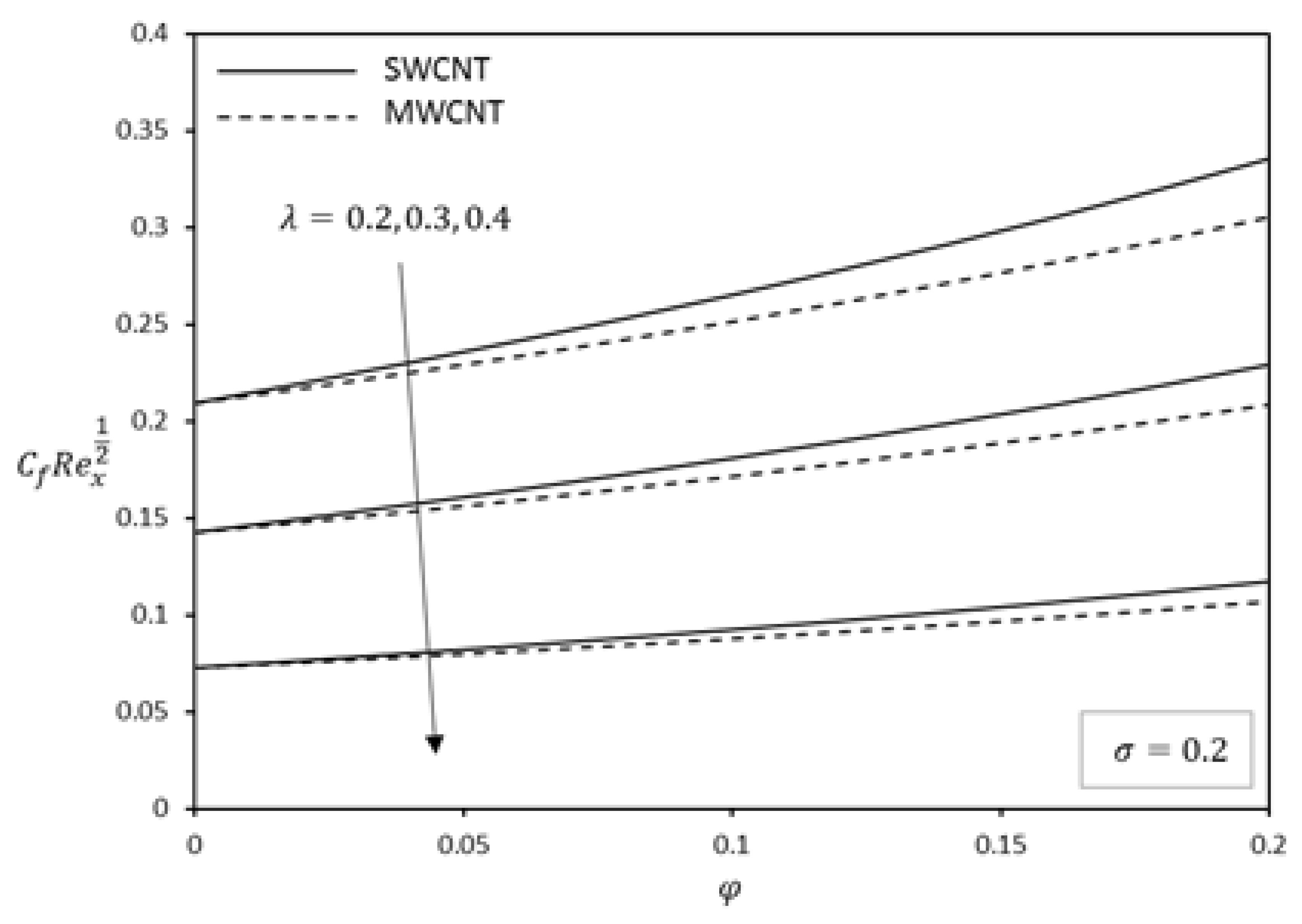
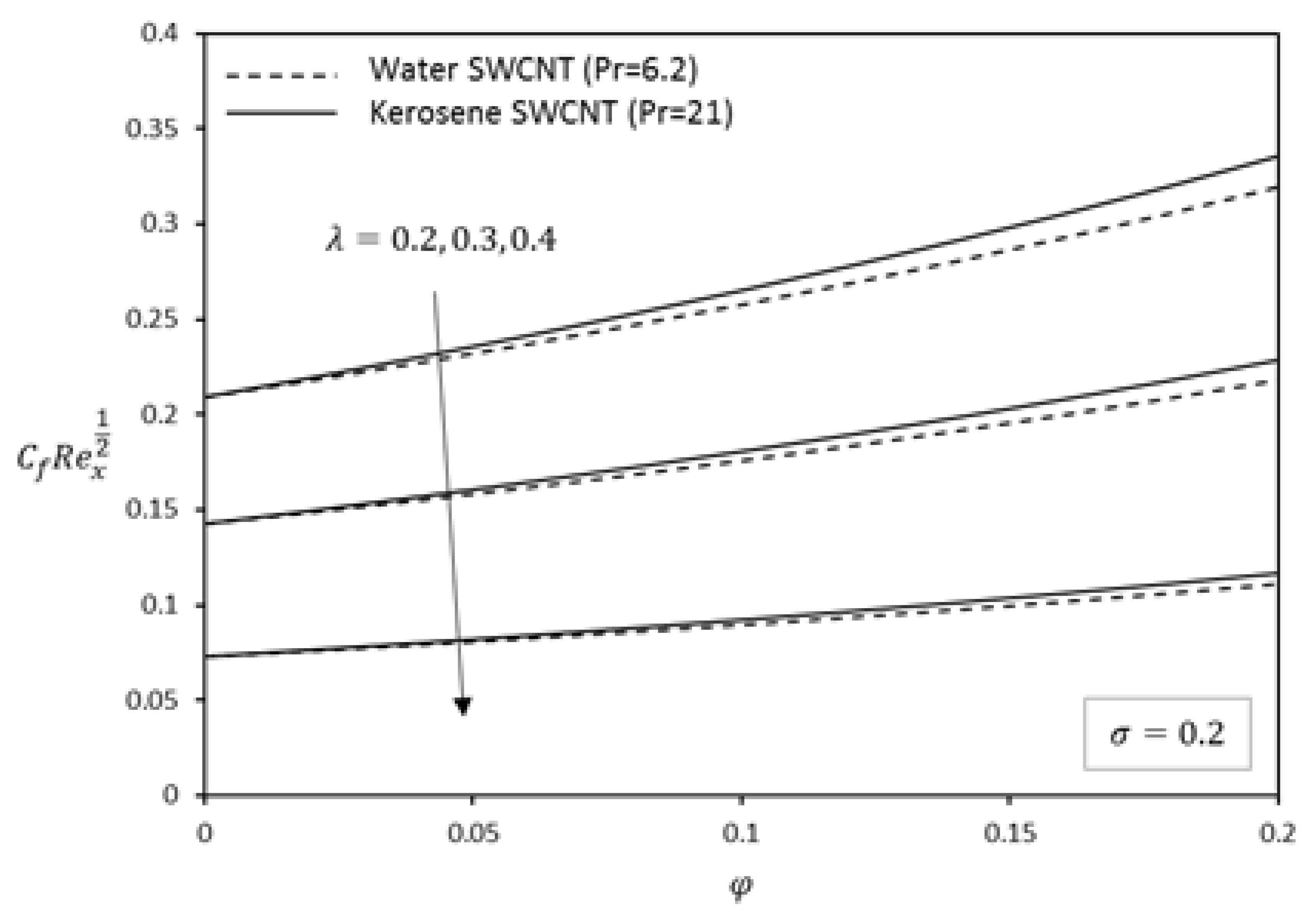



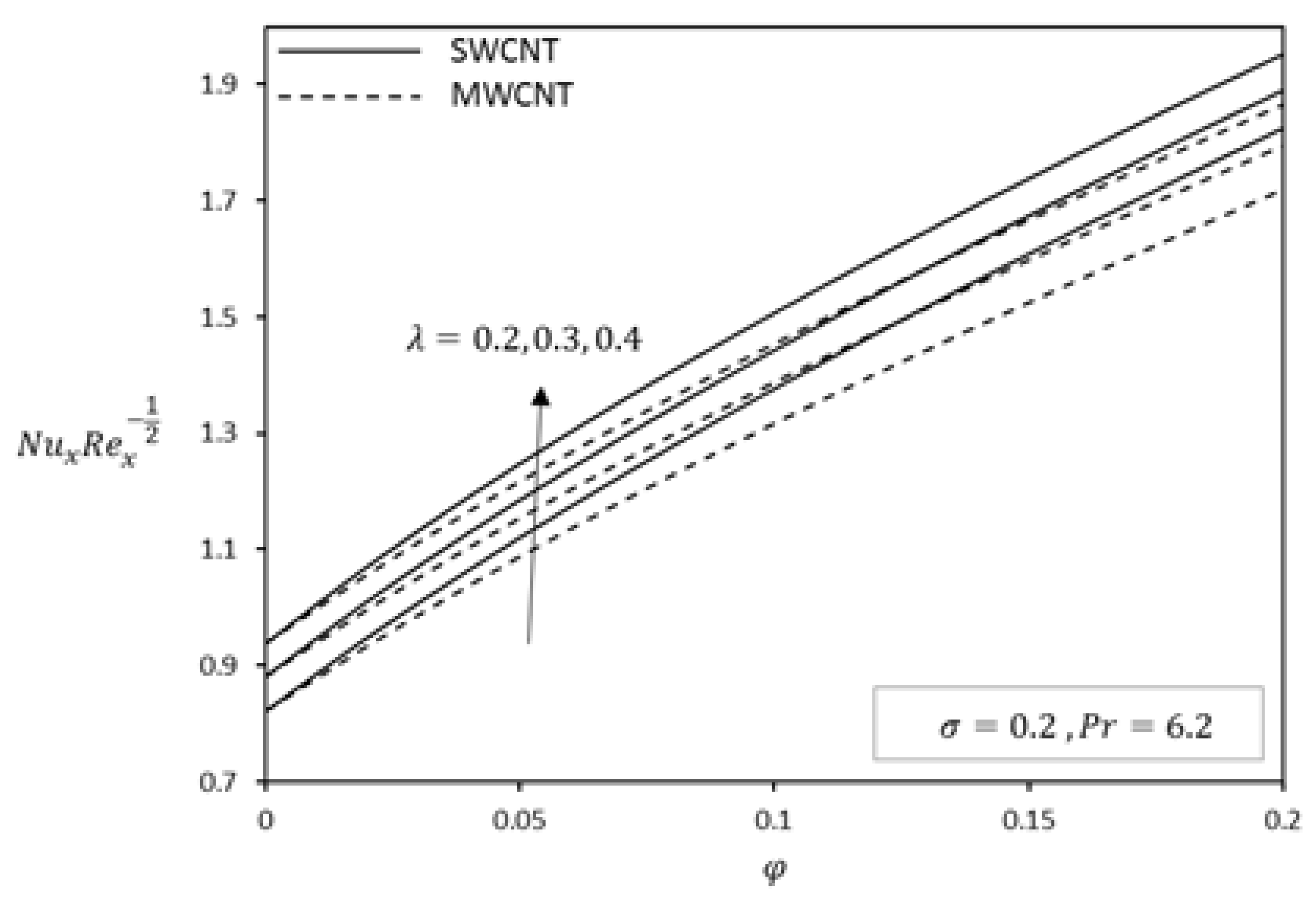



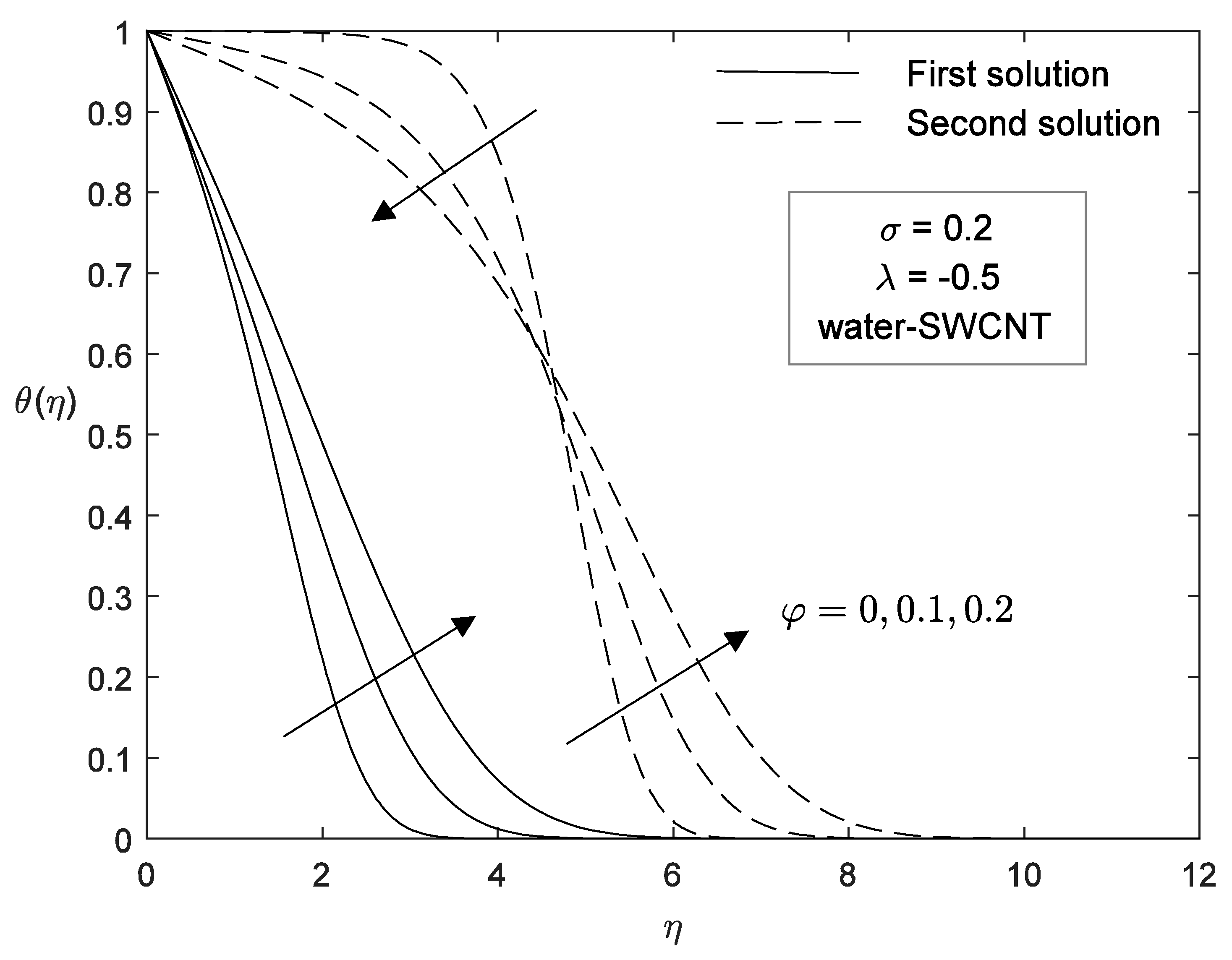

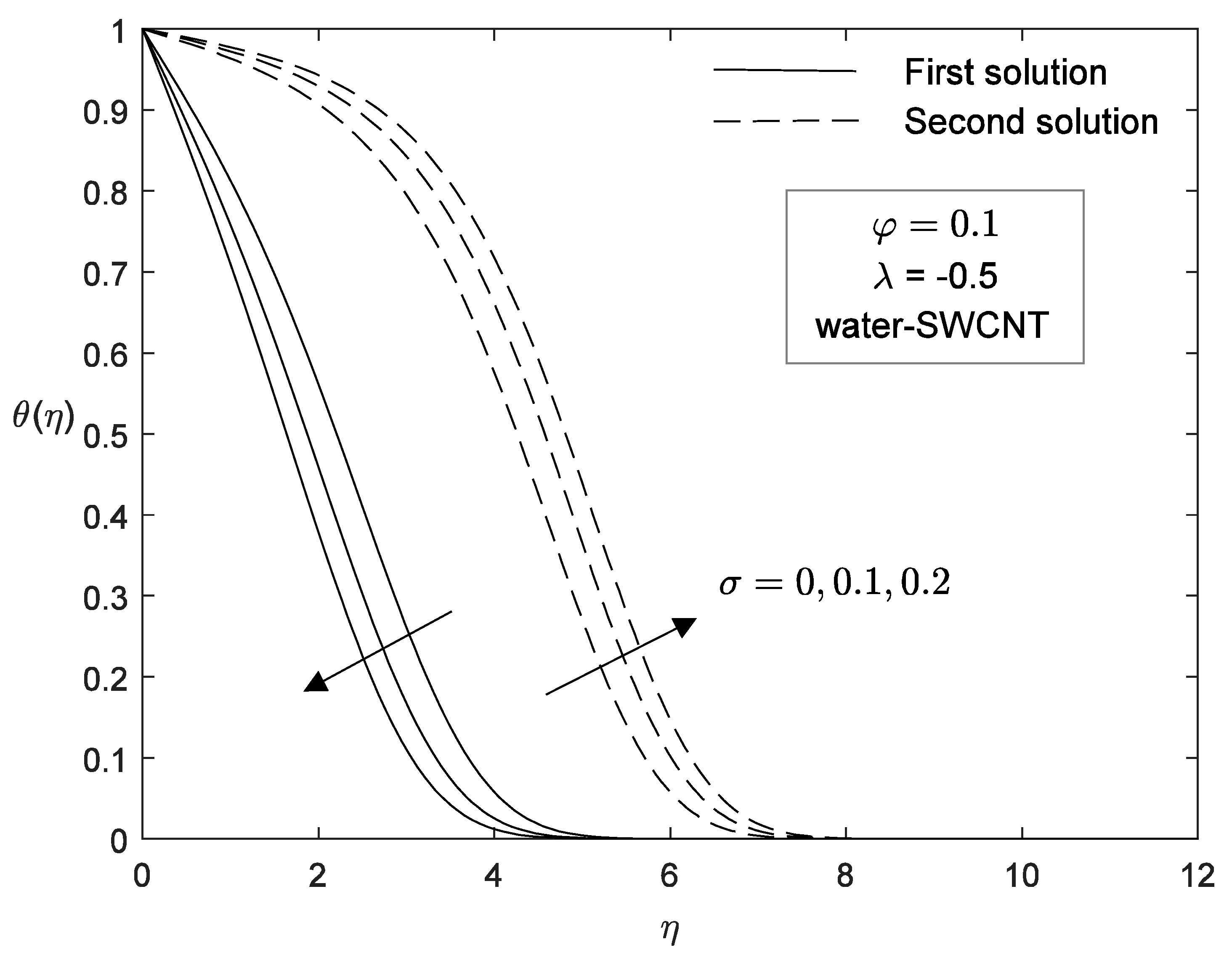
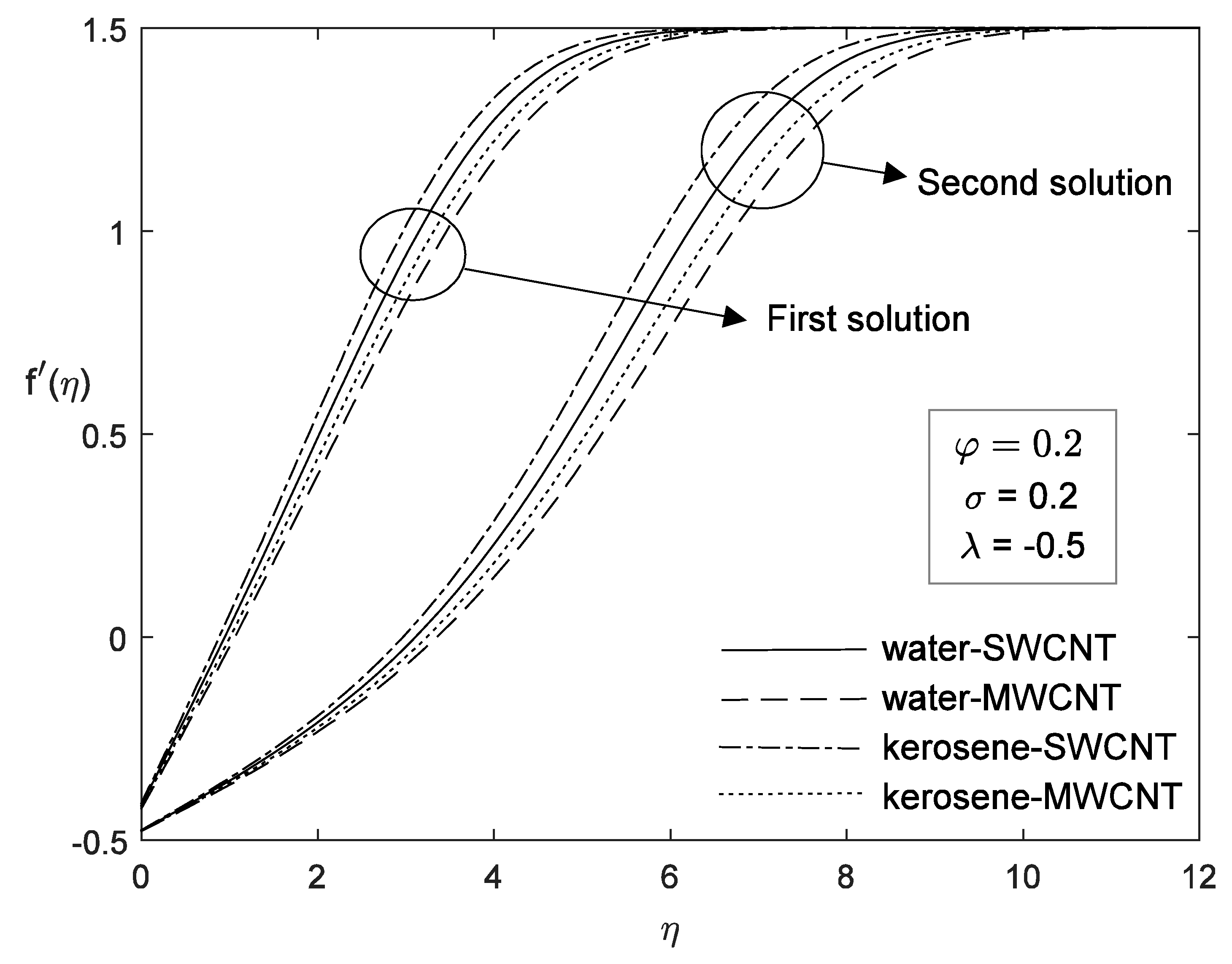

| Physical Properties | Base Fluids | Nanoparticle | ||
|---|---|---|---|---|
| Water (Pr = 6.2) | Kerosene (Pr = 21) | SWCNT | MWCNT | |
| 997 | 783 | 2600 | 1600 | |
| 4179 | 2090 | 425 | 796 | |
| 0.613 | 0.145 | 6600 | 3000 | |
| Blasius [11] | Sakiadis [14] | Bachok et al. [17] Solution | Present Result Solution | ||||
|---|---|---|---|---|---|---|---|
| First | Second | First | Second | ||||
| 0 | −0.5 | 0.3979 | 0.1710 | 0.3978 | 0.1710 | ||
| −0.4 | 0.4357 | 0.0834 | 0.4356 | 0.0834 | |||
| −0.3 | 0.4339 | 0.0367 | 0.4339 | 0.0367 | |||
| −0.2 | 0.4124 | 0.0114 | 0.4124 | 0.0114 | |||
| −0.1 | 0.3774 | 0.0010 | 0.3774 | 0.0011 | |||
| 0 | 0.332 | 0.3321 | 0.3321 | ||||
| 0.5 | 0 | 0 | |||||
| 1 | −0.44375 | −0.4438 | −0.4438 | ||||
| 0.1 | −0.5 | 0.3757 | 0.1615 | ||||
| −0.4 | 0.4114 | 0.0787 | |||||
| −0.3 | 0.4098 | 0.0345 | |||||
| −0.2 | 0.3895 | 0.0107 | |||||
| −0.1 | 0.3564 | 0.0010 | |||||
| 0 | 0.3136 | ||||||
| 0.5 | 0 | ||||||
| 1 | −0.4191 | ||||||
| 0.2 | −0.5 | 0.3460 | 0.1488 | ||||
| −0.4 | 0.3789 | 0.0725 | |||||
| −0.3 | 0.3774 | 0.0307 | |||||
| −0.2 | 0.3587 | 0.0099 | |||||
| −0.1 | 0.3282 | 0.0000 | |||||
| 0 | 0.2888 | ||||||
| 0.5 | 0 | ||||||
| 1 | −0.3861 | ||||||
| Bachok et al. [21] | Present Result | |
|---|---|---|
| 0 | −0.6582 | −0.6582 |
| 0.1 | −0.6510 | |
| 0.2 | −0.6415 |
| Nanoparticles | First Solution | Second Solution | ||
|---|---|---|---|---|
| Water-SWCNT | 0 | −0.658 | 0.0069 | −0.0067 |
| −0.65 | 0.0383 | −0.0340 | ||
| −0.6 | 0.1092 | −0.0784 | ||
| 0.1 | −0.6509 | 0.0051 | −0.0050 | |
| −0.65 | 0.0133 | −0.0127 | ||
| −0.6 | 0.1020 | −0.0746 | ||
| 0.2 | −0.641 | 0.0098 | −0.0095 | |
| −0.64 | 0.0163 | −0.0155 | ||
| −0.6 | 0.0917 | −0.0689 | ||
| Water-MWCNT | 0 | −0.635 | 0.0663 | −0.0540 |
| −0.63 | 0.0736 | −0.0587 | ||
| −0.6 | 0.1092 | −0.0784 | ||
| 0.1 | −0.645 | 0.0110 | −0.0106 | |
| −0.64 | 0.0318 | −0.0287 | ||
| −0.6 | 0.0963 | −0.0715 | ||
| 0.2 | −0.633 | 0.0037 | −0.0037 | |
| −0.63 | 0.0232 | −0.0215 | ||
| −0.6 | 0.0813 | −0.0629 |
© 2018 by the authors. Licensee MDPI, Basel, Switzerland. This article is an open access article distributed under the terms and conditions of the Creative Commons Attribution (CC BY) license (http://creativecommons.org/licenses/by/4.0/).
Share and Cite
Anuar, N.S.; Bachok, N.; Pop, I. A Stability Analysis of Solutions in Boundary Layer Flow and Heat Transfer of Carbon Nanotubes over a Moving Plate with Slip Effect. Energies 2018, 11, 3243. https://doi.org/10.3390/en11123243
Anuar NS, Bachok N, Pop I. A Stability Analysis of Solutions in Boundary Layer Flow and Heat Transfer of Carbon Nanotubes over a Moving Plate with Slip Effect. Energies. 2018; 11(12):3243. https://doi.org/10.3390/en11123243
Chicago/Turabian StyleAnuar, Nur Syazana, Norfifah Bachok, and Ioan Pop. 2018. "A Stability Analysis of Solutions in Boundary Layer Flow and Heat Transfer of Carbon Nanotubes over a Moving Plate with Slip Effect" Energies 11, no. 12: 3243. https://doi.org/10.3390/en11123243





